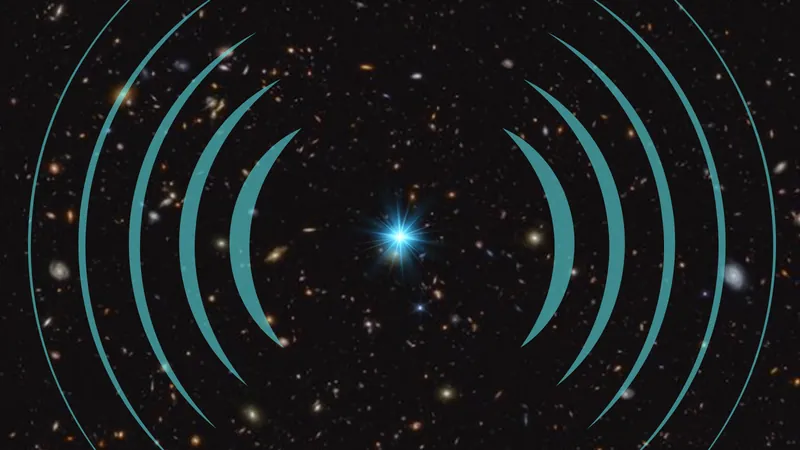
Unlocking the Secrets of the Universe's First Stars: How Ancient Radio Signals Could Weigh Their Cosmic Legacy
2025-06-24
Author: Mei
A Glimpse into Cosmic Dawn
Astronomers are on the brink of uncovering the universe’s secrets with the help of ancient radio signals from its earliest epochs, potentially 'weighing' the first stars that flickered to life in the cosmos. This monumental investigation may enlighten us about the Cosmic Dawn—a pivotal time when the darkness of the universe began to lift and the first beams of light broke free.
The Enigmatic Population III Stars
Known as Population III (Pop III) stars, these primordial lights remain hidden from even the most advanced telescopes due to a dense cosmic fog that blanketed regions rich in hydrogen. This fog acted as a barrier, stifling any light from escaping.
The 21-Centimeter Signal: A Cosmic Clue
Around 100 million years after the Big Bang, this hydrogen emitted a unique radio signal—the 21-centimeter signal. An international team of astronomers proposes that this ancient signal could provide critical insights into how light from those first stars interacted with the cosmic fog, paving the way for future illumination.
"This is a unique opportunity to learn how the universe's first light emerged from the darkness," states Anastasia Fialkov, a leading researcher from the University of Cambridge. "The transition from a cold, dark universe to one filled with stars is a story we're only beginning to understand."
REACH for the Stars: The Quest Begins
Fialkov spearheads the Radio Experiment for the Analysis of Cosmic Hydrogen (REACH), a groundbreaking initiative utilizing radio antennas to study the faint glow of the 21-centimeter signal. As REACH moves through its calibration phase, it is set to collaborate with the Square Kilometre Array (SKA), a colossal array of antennas currently being constructed in Australia and South Africa.
Innovative Strategies to Decode the 21-Centimeter Signal
In readiness for this stellar investigation, Fialkov and her team have developed a model to predict how the 21-centimeter signal will appear for both REACH and SKA. Their findings indicate that this signal is intricately linked to the masses of the universe's earliest stars.
"For the first time, we’ve successfully modeled how the 21-centimeter signal depends on the masses of these stars, including the effects of ultraviolet light and X-ray emissions from the remnants of dead stars known as X-ray binaries," Fialkov explains.
A Paradigm Shift in Understanding Early Stars
The team's research has revealed that the interplay between Pop III stars and the 21-centimeter signal had been overlooked in prior studies that neglected the dense dead star systems—often white dwarfs paired with ordinary stars—among Pop III stars.
Eloy de Lera Acedo, Principal Investigator at REACH, emphasizes the significance of their predictions, stating, "We show evidence that our radio telescopes can unveil details about the mass of those first stars, illustrating how these ancient lights might differ vastly from contemporary stars."
Bridging the Cosmic Gap with Radio Data
Unlike the James Webb Space Telescope (JWST), which captures the light from these stars directly, REACH and SKA require scientists to engage in intricate statistical analyses of the data they provide. The insights gleaned from this approach can provide comprehensive information on entire populations of stars, X-ray binary systems, and even galaxies.
Fialkov concludes, "It takes a bit of imagination to connect radio data to the story of the first stars, but the implications are profound." With every signal analyzed, we inch closer to unraveling the thrilling narrative of the universe’s infancy.

 Brasil (PT)
Brasil (PT)
 Canada (EN)
Canada (EN)
 Chile (ES)
Chile (ES)
 Česko (CS)
Česko (CS)
 대한민국 (KO)
대한민국 (KO)
 España (ES)
España (ES)
 France (FR)
France (FR)
 Hong Kong (EN)
Hong Kong (EN)
 Italia (IT)
Italia (IT)
 日本 (JA)
日本 (JA)
 Magyarország (HU)
Magyarország (HU)
 Norge (NO)
Norge (NO)
 Polska (PL)
Polska (PL)
 Schweiz (DE)
Schweiz (DE)
 Singapore (EN)
Singapore (EN)
 Sverige (SV)
Sverige (SV)
 Suomi (FI)
Suomi (FI)
 Türkiye (TR)
Türkiye (TR)
 الإمارات العربية المتحدة (AR)
الإمارات العربية المتحدة (AR)